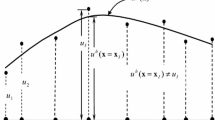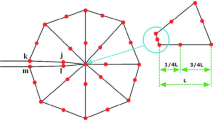Abstract
The effect of thermal shock on a cracked functionally graded material (FGM) layer is considered using the extended finite element method. Classical coupled thermoelastic equations are used in the calculations. The coupled dynamical system of equations obtained from the extended finite element discretization is solved by the Newmark method in the time domain. Micromechanical models for conventional composites are used to estimate the material properties of functionally graded layer. The interaction integral is then employed to calculate the dynamic thermal stress intensity factors (SIFs) at each time step. The effects of initial crack angle and volume fraction profiles of FGMs on SIFs are studied. Also crack propagation phenomenon is investigated in this paper. We have used MATLAB software to do the different stages of simulation from mesh generation to numerical computation of SIFs. Some numerical examples are implemented to investigate the validity and accuracy of attained results.









Similar content being viewed by others
Abbreviations
- A :
-
Element area, area (m2)
- \( A^{*} \) :
-
Area associated with the domain J-integral, area (m2)
- a :
-
Crack length, length (m)
- a :
-
Vector of nodal unknowns associated with FE shape functions, length (m)
- Bf :
-
Body force vector, force (N/m3)
- B x and B y :
-
Body force vector components, force (N/m3)
- b :
-
Vector of nodal unknowns associated with heaviside enriched shape functions, length (m)
- c :
-
Vector of nodal unknowns associated with crack tip enriched shape functions, length (m)
- C :
-
Damping matrix
- C ijkl :
-
Material constitutive matrix components (N/m2)
- c t :
-
Specific heat capacity [J/(kg K)]
- D :
-
Material modulus matrix (N/m2)
- E :
-
Young’s modulus (N/m2)
- F m :
-
Crack tip enrichment functions (m0.5)
- Fr :
-
Force vector (N)
- H :
-
Heaviside enrichment function, dimensionless
- J :
-
J integral (N/m)
- K :
-
Stiffness matrix
- K eq :
-
Equivalent dynamic stress intensity factor (N/m1.5)
- K I :
-
Mode I stress intensity factor (N/m1.5)
- K IC :
-
Fracture toughness (N/m1.5)
- K ID :
-
Fracture toughness (N/m1.5)
- K II :
-
Mode II stress intensity factor (N m1.5)
- k :
-
Thermal conductivity [W/(m K)]
- L :
-
Length of specimen, length (m)
- M :
-
Mass matrix (kg)
- MI :
-
M-integral (N/m)
- m :
-
Number of crack tip enrichment functions (m)
- N :
-
FEM shape function, dimensionless
- n x and n y :
-
Unit vectors in x and y directions
- p :
-
Power exponent determining the volume fraction profiles, dimensionless
- q :
-
Smoothing weight function, dimensionless
- q i :
-
Component of heat flux vector per unit area (W/m2)
- R :
-
Generated heat per unit volume (W/m3)
- r :
-
Polar coordinate system component, length (m)
- S :
-
Vector of XFE shape functions
- T :
-
Temperature (K)
- Tf :
-
Traction force vector (N/m2)
- t :
-
Time (s)
- t D :
-
Dimensionless time, dimensionless
- t n x :
-
Traction vector components at x direction (N/m2)
- t n y :
-
Traction vector components at y direction (N/m2)
- u :
-
Displacement vector (m)
- V :
-
Volume (m3)
- V i :
-
Volume fraction of inclusion, dimensionless
- W :
-
Height of specimen, length (m)
- X :
-
Global Cartesian coordinate system component
- x :
-
Local Cartesian coordinate system component
- α :
-
Coefficient of thermal expansion (1/K)
- β :
-
Coupling term [N/(m2 K)]
- β i :
-
Universal functions, dimensionless
- γ :
-
Coefficient of Newmark method, dimensionless
- ζ :
-
Coefficient of Newmark method, dimensionless
- δ ij :
-
Kronecker delta, dimensionless
- ε :
-
Strain tensor, dimensionless
- ε aux :
-
Auxiliary strain tensor, dimensionless
- ε m ij :
-
Mechanical strain component, dimensionless
- θ :
-
Temperature change (K)
- μ :
-
Lamé constant (N/m2)
- λ :
-
Lamé constant (N/m2)
- υ :
-
Poisson’s ratio, dimensionless
- ρ :
-
Density (kg/m3)
- φ :
-
Polar coordinate system component, dimensionless
- σ :
-
Stress tensor (N/m2)
- σ aux :
-
Auxiliary stress tensor (N/m2)
- Φ:
-
Enrichment shape function, dimensionless
- Ψ:
-
Enrichment shape function, dimensionless
- ω :
-
The angle between local and global coordinate systems, dimensionless
- ω c :
-
Crack propagation direction, dimensionless
- Δ:
-
Nodal displacements and temperature changes vector
- h :
-
Relative to nodes in an element
- i :
-
Relative to components of Cartesian coordinate system
- j :
-
Relative to components of Cartesian coordinate system
- l :
-
Relative to the shape functions
- m :
-
Relative to crack tip enrichment functions
- n :
-
Relative to nodes, time step and component of coordinate system
- ne :
-
Relative to nodes in element e
- ns :
-
Relative to XFE shape functions
- tip:
-
Relative to crack tip
- 1:
-
Relative to the horizontal axis of coordinate system
- 2:
-
Relative to the vertical axis of coordinate system
- aux:
-
Relative to auxiliary field
References
Azadi M, Azadi M (2009) Nonlinear transient heat transfer and thermoelastic analysis of thick walled FGM cylinder with temperature dependent material properties using Hermitian transfinite element. J Mech Sci Technol 23:2635–2644
Bao G, Cai H (1997) Delamination cracking in functionally graded coating/metal substrate systems. Acta Mater 45(3):1055–1066
Belytschko T, Moës N, Usui S, Parimi C (2001) Arbitrary discontinuities in finite elements. Int J Numer Methods Eng 50(4):993–1013
Black T, Belytschko T (1999) Elastic crack growth in finite elements with minimal remeshing. Int J Numer Methods Eng 45:601–620
Duflot M (2008) The extended finite element method in thermoelastic fracture mechanics. Int J Numer Methods Eng 74:827–847
Ekhlakov AV, Khay OM, Zhang Ch, Sladek J, Sladek V (2012) A BDEM for transient thermoelastic crack problems in functionally graded materials under thermal shock. Comput Mater Sci 57:30–37
Feng Y, Jin Z (2009) Thermal fracture of functionally graded plate with parallel surface cracks. Acta Mech Solida Sin 22(5):453–464
Fujimoto T, Noda N (2000) Crack propagation in a functionally graded plate under thermal shock. Arch Appl Mech 70(6):377–386
Fujimoto T, Noda N (2001) Two crack growths in a functionally graded plate under thermal shock. J Therm Stress 24:847–862
Gaudette FG, Giannakopoulos AE, Suresh S (2001) Interface cracks in layered materials subjected to a uniform temperature change. Int J Fract 110(4):325–349
Gerlach CA (1999) “omputational methods for the dynamic response of cracked specimens. PhD thesis, Northwestern university, Evanston, IL
Hatta H, Taya M (1986) Equivalent inclusion method for steady state heat conduction in composites. Int J Eng Sci 24:520–524
Hetnarski RB, Eslami MR (2009) Thermal stresses—advanced theory and applications. Springer, Berlin
Hosseini-Tehrani P, Eslami MR, Daghyani HR (2001) Dynamic crack analysis under coupled thermoelastic assumption. J Appl Mech 68(4):584–588
Hosseini-Tehrani P, Hosseini-Godarzi AR, Tavangar M (2005) Boundary element analysis of stress intensity factor KI in some two dimensional dynamic thermoelastic problems. Eng Anal Bound Elem 29:232–240
Hughes TJR (1987) The finite element method. Prentice-Hall, Englewood Cliffs
Jin Z-H, Batra RC (1996) Some basic fracture mechanics concepts in functionally graded materials. J Mech Phys Solid 44:1221–1235
Jin Z-H, Paulino GH (2001) Transient thermal stress analysis of an edge crack in a functionally graded material. Int J Fract 107:73–98
KC A, Kim J-H (2008) Interaction integrals for thermal fracture of functionally graded materials. Eng Fract Mech 75:2542–2565
Kim J-H, Paulino GH (2002) Isoparametric graded finite elements for nonhomogeneous isotropic and orthotropic materials. ASME J Appl Mech 69:502–514
Lee KY, Sim KB (1990) Thermal shock stress intensity factor by Bueckner’s weight function method. Eng Fract Mech 37(4):799–804
Lee YD, Erdogan F (1998) Interface cracking of FGM coatings under steady-state heat flow. Eng Fract Mech 59(3):361–380
Lee YD, Erdogan F (1995) Residual/thermal stresses in FGM and laminated thermal barrier coatings. Int J Fract 69:145–165
Melenk JM, Babuška I (1996) The partition of unity finite element method: basic theory and applications. Comput Methods Appl Mech Eng 139(1–4):289–314
Menouillard T, Song J-H, Duan Q, Belytschko T (2010) Time dependent crack tip enrichment for dynamic crack propagation. Int J Fract 162:33–49
Moës N, Dolbow J, Belytschko T (1999) A finite element method for crack growth without remeshing. Int J Numer Methods Eng 46(1):131–150
Mori T, Tanaka K (1973) Average stress in matrix and average elastic energy of materials with misfitting inclusions. Acta Mater 21:571–574
Noda N (1997) Thermal stress intensity factor for functionally gradient plate with an edge crack. J Therm Stress 20(3–4):373–387
Quian G, Nakamura T, Berndt CC (1998) Effects of thermal gradient and residual stresses on thermal barrier coating fracture. Mech Mater 27:91–110
Rice JR (1968) A path-independent integral and the approximate analysis of strain concentration by notches and cracks. ASME J Appl Mech 35(2):379–386
Song SH, Paulino GH (2006) Dynamic stress intensity factors for homogeneous and smoothly heterogeneous materials using the interaction integral method. Int J Solid Struct 43:4830–4866
Stolarska M, Chopp DL, Moës N, Belytschko T (2001) Modeling crack growth by level sets in the extended finite element method. Int J Numer Methods Eng 51:943–960
Swenson DV, Ingraffea AR (1988) Modeling mixed-mode dynamic crack propagation using finite elements: theory and applications. Comput Mech 3:381–397
Williams ML (1957) On the stress distribution at the base of a stationary crack. ASME J Appl Mech 24(1):109–114
Zamani A, Eslami MR (2009) Coupled dynamical thermoelasticity of a functionally graded cracked layer. J Therm Stress 32:969–985
Zamani A, Eslami MR (2010) Implementation of the extended finite element method for dynamic thermoelastic fracture initiation. Int J Solid Struct 47:1392–1404
Author information
Authors and Affiliations
Corresponding author
Additional information
Technical Editor: Lavinia Borges.
Rights and permissions
About this article
Cite this article
Rokhi, M.M., Shariati, M. Implementation of the extended finite element method for coupled dynamic thermoelastic fracture of a functionally graded cracked layer. J Braz. Soc. Mech. Sci. Eng. 35, 69–81 (2013). https://doi.org/10.1007/s40430-013-0015-0
Received:
Accepted:
Published:
Issue Date:
DOI: https://doi.org/10.1007/s40430-013-0015-0




